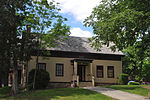Troy Hills, New Jersey
AC with 0 elementsCensus-designated places in Morris County, New JerseyCensus-designated places in New JerseyNew Jersey geography stubsParsippany-Troy Hills, New Jersey
Troy Hills is a census-designated place (CDP) in the township of Parsippany-Troy Hills, Morris County, New Jersey, United States. It is in the southeast part of the township, bordered to the north and west by the Parsippany CDP, to the south by Whippany in Hanover Township, and to the east by Troy Meadows, the largest freshwater marsh in New Jersey. Interstate 80 forms the northern edge of the CDP, and Jefferson Road is the western edge. Troy Hills is 6 miles (10 km) northeast of Morristown and 17 miles (27 km) northwest of Newark. The community was first listed as a CDP prior to the 2020 census.
Excerpt from the Wikipedia article Troy Hills, New Jersey (License: CC BY-SA 3.0, Authors).Troy Hills, New Jersey
South Beverwyck Road,
Geographical coordinates (GPS) Address Nearby Places Show on map
Geographical coordinates (GPS)
| Latitude | Longitude |
|---|---|
| N 40.8525 ° | E -74.392222222222 ° |
Address
South Beverwyck Road 453
07054
New Jersey, United States
Open on Google Maps






